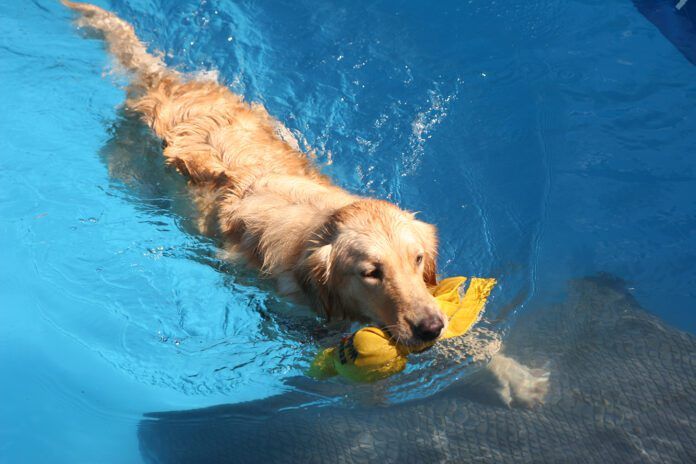
The term “dog paddle” has become synonymous with staying afloat in the water. It’s the first swim stroke most children learn – moving their hands and legs alternately – in a way that’s similar to how experienced dogs and other quadrupedal mammals swim.
The key word is “experienced.” Inexperienced (or panicked) dogs often concentrate their efforts on the front legs, forgetting to fire up the back end. Front-end-only swimming is ineffective and leaves dogs near-vertical in the water. It creates a lot of disorienting splashing, requires tremendous energy, and is a dangerous way for your dog to enjoy a dip in the pool, lake, or ocean.
The following two tips will help your dog improve his swim stroke:
- Support your dog’s back end. Joining your dog in the water and gently supporting his back end as he swims can help him learn to level out and begin using his front and rear legs in unison. For dogs who still lag in kicking their rear legs, touching their feet underwater can prompt kicking.
- Use a well-fitted life jacket. A dog life jacket can help keep your dog afloat and help anxious swimmers begin to relax enough to think about paddling with all four legs. (See “Dog Life Jacket Review,” WDJ August 2021, for recommendations.)
Dog Water Safety Training
Keep these things in mind to help ensure safe swimming:
- Body type matters! Your dog’s breed, build, and overall health have a lot to do with how effectively she can handle herself in the water. Breeds with broad chests and shorter legs (Bulldogs, Corgis, Pugs, etc.) aren’t designed for effective swimming. Heavily muscled dogs – like many of the so-called “bully” breeds – exert a lot of energy in the water due to their greater body mass.
- Teach your dog to safely enter and exit the pool. Ideally, your dog will enter and exit the pool only via the steps. Even accomplished swimmers can drown while unsuccessfully trying to claw their way out from the edge of the pool. And dog cannonball entrances, while fun to watch, are unsafe when dogs and people are simultaneously in the water.
Start by making the top step of the pool a great place to be by feeding your dog high-value treats at that location. Eventually carry or guide your dog into the water a few feet from the steps and release him to swim back to the steps where a party awaits. Repeat until your dog is patterned to head toward the steps from any direction.
- Everything in moderation. Swimming is a great way for dogs to burn excess energy, stay in shape, and even shed some unwanted pounds, but don’t overdo it. The more overweight the dog, the faster he will tire. Watch out for “weekend warrior syndrome,” where a dog who is mostly sedentary suddenly gets too much exercise. Dogs, like people, experience muscle soreness and stiffness.
Swim school for dogs
If you want to make sure your dog will be safe near and in the water, but aren’t comfortable teaching the skills yourself, look for a positive reinforcement trainer to help you. Many dog trainers offer water safety training and many training facilities features pools where your dog can perfect his skills and enjoy fun water play.





